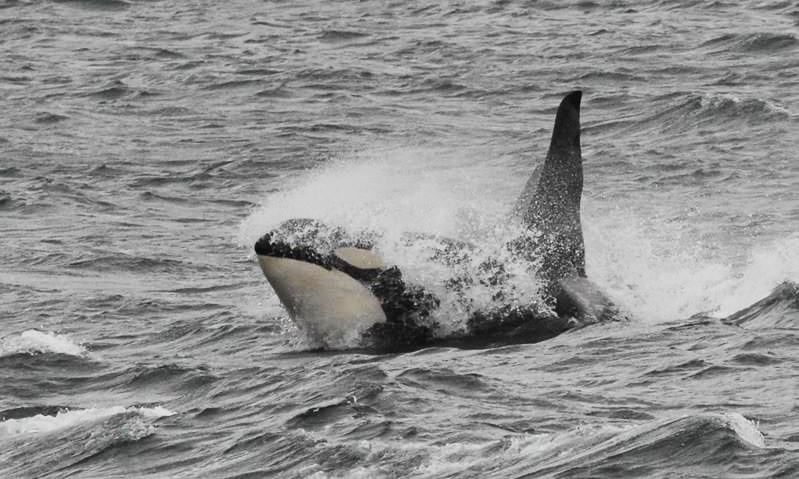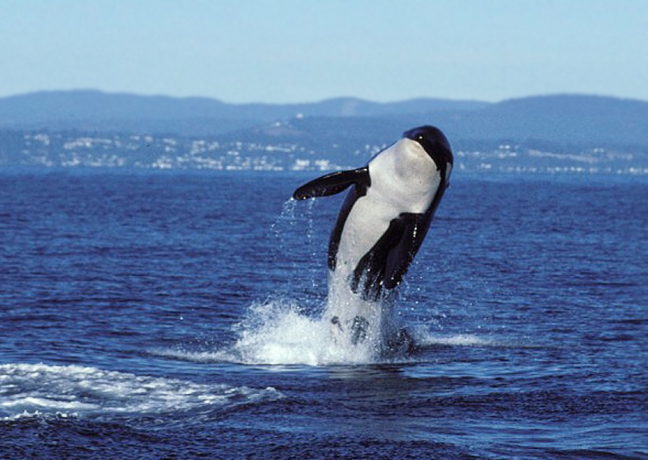The Mystery Of The Killer Whale Baby Boom
In the Pacific Northwest, scientists are wondering why so many of one clan’s calves are turning out to be boys.
By Vicki Croke
It’s the biggest baby boom since 1977 for a population of 84 killer whales who are frequently seen in and around Puget Sound. Nine new calves alive and well, have been spotted between December of 2014 and January of this year among the endangered Southern Resident Killer Whales. These are the members of an extended family or clan, made up of the J, K, and L pods, and the only resident population to occur in the United States. It is one of the most studied groups anywhere in the world.
But the researchers who spend their lives observing these animals, are filled with as much concern as they are wonder.
It isn’t the way the babies look or behave. The calves appear robust and full of energy. On this score, even the most sober of whale scientists can be almost giddy.
Members of J-pod in Puget Sound swim with new calf, J55. Spotted on January 18, 2016. Video courtesy of NOAA.
Take Deborah Giles, research director and programs manager for the Center for Whale Research. I interviewed her by phone, and after spending a half hour talking about biology, behavior, and history of these animals, I asked her what the babies look like.
“The families play with the babies. They lift them up out of the water, and they pass the babies back and forth.” —Deborah Giles
“Oh! They’re ridiculously cute!” she says, before mocking herself for the way she sometimes talks about the calves. But, still, she continues: “I mean, they’ve got little snub noses, they kind of swim differently than a larger whale—when they jump out of the water, they look more like a salmon—they kind of like fling their body around just to clear the water. In a perfect world, they’re these chubby little sausages, black and white sausages.”
And right now, Giles, says, “The families play with the babies. They lift them up out of the water, and they pass the babies back and forth.”
But in the midst of the joy of seeing these calves, there’s a concern and it involves the number of females to males. Something odd may be brewing.

Adorable, and most recent: Killer whale calf J55. Killer whale calves are 7 or 8 feet long at birth and weigh about 400 pounds. Courtesy: NOAA.
There appears to be an imbalance in the sex ratio. It may be as lopsided as eight males to one female. The scientists need to get good clear images of the calves’ undersides to determine sex. And, at the moment, they know there is one female, and they know there are four males, but there are varying degrees of suspicion about the gender of the remaining four—they might all turn out to be boys too.
This is not a normal ratio, and since the females, obviously, give birth to babies, they are vital to the stability and growth of the population. The concern, “a fairly significant fear,” says Giles, is that toxins in the water are causing the “male-bias.”
The National Oceanic and Atmospheric Administration lists contaminants at the top of their list for threats to this species.
And two new studies have just come out over the last few weeks. One from Scripps Institution of Oceanography in San Diego about so-called POPs or persistent organic pollutants and the contamination of fish across the world’s oceans.

Beautiful J1, or “Ruffles,” was last seen in 2010. He was thought to be Granny’s son. Courtesy: Center for Whale Research.
And another, led by a wildlife veterinarian from the Zoological Society of London, and published in the journal Scientific Reports, reveals the “dangerously high levels” of PCBs found in Europe’s dolphins and killer whales.
Many of these pollutants—PCBs, DDT— have been banned for decades, but they’re called “legacy” chemicals because they still haunt the environment.
And that presents special problems for top-of-the-food-chain animals like killer whales.
Carl Safina, a MacArthur genius-grant recipient, ecologist, and marine conservation visionary, says that, indeed, pollution may really turn out to be the culprit in a sex ratio imbalance.
“Killer whales are very polluted animals. That’s the incredible tragedy of it.” —Carl Safina
In an interview by phone, Safina says, “There’s so much known about how various kinds of modern chemicals can affect hormones, and do affect the genders of the offspring of various kinds of animals that it’s not at all surprising, and I don’t doubt that the gender ratios of killer whales could be affected. I don’t think it’s yet proven that this is exactly what’s happening. But we do know because killer whales are the very top of a long food chain that they concentrate all of the chemicals that we are putting in the water. And they’re living in an incredible soup of various kinds of industrial and agricultural toxins.”
Killer whales “are very polluted animals,” Safina says, “that’s the incredible tragedy of it.”
In his new book, “Beyond Words: What Animals Think and Feel,” Safina beautifully profiles the remarkable intellect and emotional lives of animals, including killer whales. And he makes clear how amazing killer whales are.
“Intelligent, maternal, long-lived, cooperative, intensely social, devoted to family. They are, like us, warm-blooded milk-makers, mammals whose personalities are really not much different from ours. They’re just a lot bigger. And notably less violent,” he writes.
“They share food with their family even to their own detriment. When they are thin and need food, they still share their food with their family.” —Deborah Giles
Killer whales share food. And, as big as they are—males can weigh 22,000 pounds—a whale from the Southern Resident group will, Giles says, bite a salmon, “which they could easily gulp down in one gulp,” into thirds to share it. “They share food with their family even to their own detriment,” Giles says. “When they are thin and need food, they still share their food with their family.”
Killer whale sons and daughters live with their mothers their whole lives. And even though males are much bigger than females, it’s females who lead the families. As Safina points out, “killer whales maintain a social structure more complex than chimpanzees’.”
They appear to grieve when they lose a loved one—and moms will sometimes heartbreakingly carry around deceased calves—that just happened here recently, according to Giles, when J31’s calf died. “It really illustrates the tight bond these animals have with their offspring, even right at birth,” Giles says.
But the bonds are tight across all members of the family. Researchers aren’t even sure who exactly the mother of the latest baby—J55— is because all the females in that family swim so close to him or her, forming a tight, protective living shield.
And the concern of the killer whales seems to, on occasion, spread to other species. Like humans. There are stories in the literature about people who report that killer whales helped them navigate when they were lost in the fog out in the water. Famed killer whale expert Ken Balcomb is among them.
We can wonder at killer whales. They use sound—clicks and whistles and calls— to echolocate prey and to communicate with each other. “Killer whales of different populations have distinct calls and whistles,” according to NOAA.
It’s easy to see why we want to save them, but how do we do it?
A lot of it, according to Giles, is going to come down to making sure they have enough food.
According to the US government, depletion of prey is one of the biggest threats to these animals. So salmon restoration is essential. And there needs to be “a slice of the pie,” Giles says, “that has the whale’s name on it.”
Having enough salmon keeps them alive, allows them to congregate, which is vital to this highly social species, and it even helps them deal with those environmental toxins, because, Giles says, when they don’t get enough to eat, they start metabolizing their blubber and that is what releases the stored toxins, which then begin to circulate through their system.
When given a chance, killer whales can lead astonishingly long lives. That’s been proven by Granny, or J2. She’s considered to be the oldest known killer whale. She may be as young as 85, but is thought to be more like 105.

Go, Granny, go! J2, or “Granny,” may be as old as 105, but she’s still athletic. Courtesy: Orca Network.
And she’s still an incredible athlete—she’s one of the killer whales famous for frequent breaching—that means that she still heaves herself athletically and completely out of the water.
But Giles looks back at so many individual killer whales who have meant so much to her—L57, who was “long, tall, and lean,” irresistible to females, and whom she called the Clint Eastwood of Killer Whales. There’s K20, called “Spock,” who was thought to be a male until she showed up one day with a calf. And L87 who found new families after his mother died.
Giles has spent so much of her life studying these animals that she says, “They feel like family. It feels weird when you don’t see them for a while.”



4 Responses to “The Mystery Of The Killer Whale Baby Boom”
Awww. What makes CWR suspect four male calves?
Predivno, samo da Japanci ne saznaju oni su mega zločinci kitova.
Love these babies! Such joy and hope for the future in every one. #FreeTheSnake so they will grow big & strong & old
Among certain Inuit populations that eat a lot of marine mammals (and thus have high levels of estrogen imitating POPs) the birth ratios are tilted in favor of female babies.
Comments are closed.